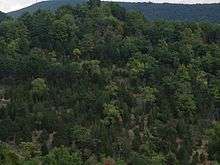Carex juniperorum
Carex juniperorum, the juniper sedge, is a perennial flowering plant native to North America, first described by botanist William J. Crins in 1993.[2] C. juniperorum is in the Cyperaceae (sedge) family, and is closely related to C. jamesii and C. willdenowii. It is commonly called juniper sedge as it is often seen growing in areas with red cedar (Juniperus virginiana), though the presence of cedar is not necessarily a requirement for it to grow.[3]

| Carex juniperorum | |
|---|---|
| Scientific classification | |
| Kingdom: | Plantae |
| Clade: | Tracheophytes |
| Clade: | Angiosperms |
| Clade: | Monocots |
| Clade: | Commelinids |
| Order: | Poales |
| Family: | Cyperaceae |
| Genus: | Carex |
| Species: | C. juniperorum |
| Binomial name | |
| Carex juniperorum | |
Distribution
Juniper sedge is globally rare. It only occurs in sections of Ohio, Kentucky, and Virginia in the United States. In Canada, it is found in the province of Ontario.[4] [5] [6]
Description and habitat
Juniper sedge prefers dry, open, calcareous soils that are periodically disturbed to maintain canopy cover.[7] [8] The plant grows forming a clump, with grass-like leaves up to 30cm long with a reddish-brown basal sheath. Flowers occur in early may on a small basal spike. Small (1.5-2mm) ellipsoid perigynia form in late May lasting until late June. [9]
Risks
Cyperus juniperorum faces habitat risk from fire suppression, invasive plant succession, development and habitat fragmentation. the sedge requires open habitat to grow and through fire suppression, land use changes, and increased invasive plant presence such as Alianthus altissima have threatened existing populations. [10] To ensure the survival of the species proper land management techniques must be implemented to keep existing habitat clear of secondary growth that may outcompete juniper sedge.
References
- Catling, Paul Miles; Reznicek, Anton Albert; & Crins, William J., Systematic Botany; Quarterly Journal of the American Society of Plant Taxonomists/ 18: 497, fig. 1
- Catling, P.M., A.A. Reznicek, and W.J. Crins. 1993. Carex juniperorum (Cyperaceae), a new species from northeastern North America, with a key to Carex sect. Phyllostachys. Systematic Botany 18(3): 496-501.
- Catling, P.M., A.A. Reznicek, and W.J. Crins. 1993. Carex juniperorum (Cyperaceae), a new species from northeastern North America, with a key to Carex sect. Phyllostachys. Systematic Botany 18(3): 496-501.
- Wayne National Forest. 2003. Species data collection form, Carex juniperorum (June 4, 2003, updated September 30, 2003).
- Division of Natural Areas and Preserves. 2001. Rare native Ohio plants, 2000-2001 status list (20 October 2002). Ohio Department of Natural Resources, Ohio.
- Belden, A., Jr., G.R. Fleming, J.C. Ludwig, J.F. Townsend, N.E. Van Alstine, and T.F. Wieboldt. 2004. Noteworthy collections: Virginia. Castanea 69: 144-153.
- Anderson, Roger C., James S. Fralish, and Jerry M. Baskin. Savannas, barrens, and rock outcrop plant communities of North America. Cambridge, UK New York, NY, USA: Cambridge University Press, 1999. Print.
- Polgar, S.K. 2008. Prioritizing Management of Ailanthus altissima at the Edge of Appalachia Preserve. Electronic Masters Thesis. Document number: ohiou1198354827. Ohio University
- Catling, P.M., A.A. Reznicek, and W.J. Crins. 1993. Carex juniperorum (Cyperaceae), a new species from northeastern North America, with a key to Carex sect. Phyllostachys. Systematic Botany 18(3): 496-501.
- Polgar, S.K. 2008. Prioritizing Management of Ailanthus altissima at the Edge of Appalachia Preserve. Electronic Masters Thesis. Document number: ohiou1198354827. Ohio University
